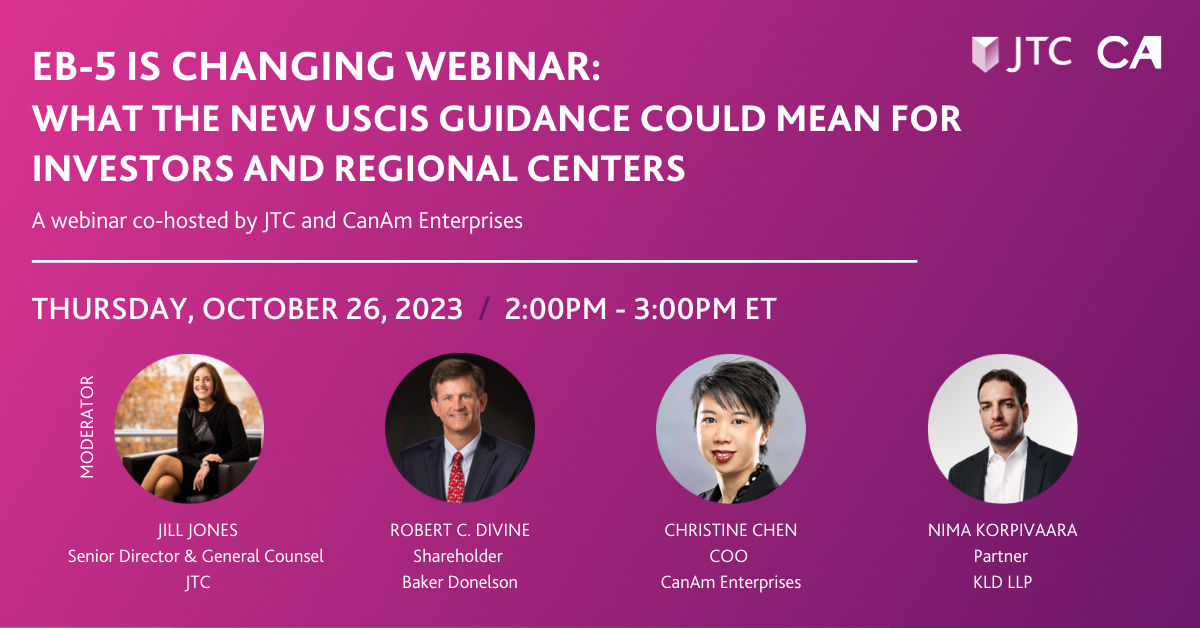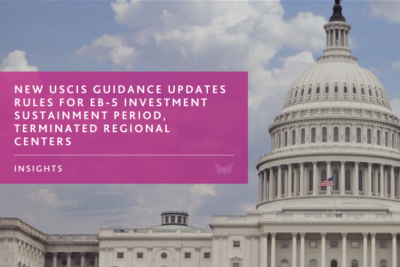Redeployment of EB-5 capital has certainly become one of the main concerns of both current and prospective EB-5 investors. CanAm’s article, “EB-5 Capital Redeployment: Investors First!”, explains why there is a need for EB-5 capital redeployment and describes the current requirements. As a compliment to this introduction, CanAm is pleased to introduce its EB-5 capital redeployment solutions and presents the options it will offer to its EB-5 investors.
When investors first chose their EB-5 investments and filed their I-526 Petitions, most focused on the EB-5 project’s ability to be completed and to create the required number of jobs. For EB-5 investors whose projects have successfully created the necessary jobs and repaid the EB-5 loan, those that are visa-backlogged and must redeploy their EB-5 capital in order to maintain their investment “at risk” until they are permitted to file their I-829 Petitions are facing additional decisions. No doubt the two top concerns on their minds are:
• How do I know that the redeployment investment will be USCIS-compliant, so I do not jeopardize my I-829 Petition?
• How do I make sure my capital is preserved until I am eligible to be repaid?
With China, Vietnam and India currently subject to EB-5 visa backlogs of varying durations, and several other countries projected to retrogress before the end of the current federal fiscal year, in any given EB-5 limited partnership, each investor has a unique redeployment timeframe, liquidity needs, and risk tolerance. For that reason, it does not make sense for a Regional Center to only offer all of its investors a one-size-fits-all redeployment investment. That’s why CanAm’s redeployment solution seeks to provide options intended to meet the specific needs of its investors.
How do I know that the redeployment investment will be USCIS-compliant, so I do not jeopardize my I-829 Petition?
Although the USCIS Policy Manual currently provides limited guidance on the types of investments that will meet the agency’s criteria for redeployment, it does mention two examples of acceptable redeployment investments – namely a redeployment into another construction project or new issue municipal bonds, such as for infrastructure spending. While the EB-5 stakeholder community is presently advocating for USCIS to confirm that the scope of permissible redeployment vehicles is broader than these two examples (e.g., to include any investments in marketable securities), the USCIS has yet to do so. Therefore, for the time being, CanAm has decided that its current redeployment options should include, depending on market availability, the following:
• Municipal bonds intended for infrastructure-related spending;
• Mezzanine loans to qualifying real estate developers; and/or
• Longer-term preferred equity investments in real estate projects
While it is important to understand what types of investments would meet USCIS’s redeployment requirements, it is equally important to know what USCIS does not require. In the EB-5 community, there has been great deal of debate as to whether investors’ funds have to be redeployed into another EB-5 project to meet USCIS requirements. In fact, USCIS does not require repaid capital be redeployed into another EB-5 project and under no circumstances will CanAm be offering EB-5 projects to its investors as redeployment investments. As far as CanAm is concerned, our investors whose EB-5 projects have already met the job creation requirements but need to redeploy should be presented with market-rate investment projects that provide quality returns but at much less risk than their original EB-5 investment.
Introducing CanAm’s EB-5 Redeployment Solution: An Investors-First Approach
CanAm recognizes that the decision about redeployment is an important one. CanAm’s philosophy throughout its more than 30 years of history in structuring and promoting immigration-linked investments has always remained the same: to ensure that investors complete their immigration goals and preserve their capital investments. CanAm’s position over the past 15+ years of sponsoring EB-5 projects reflects our commitment to maintain reasonable EB-5 loan terms and predictable maturity dates without locking investors into longer commitments and/or multi-year extensions that carry greater risk and tend to favor developers.
This same “investor-first” mindset has guided CanAm’s approach to developing its redeployment strategy, which is not limited to a single redeployment option to all of its investors, but rather, provides different investment options intended to suit the needs of its specific investors depending on the duration of their respective redeployment periods, liquidity needs, desired capital returns, and risk tolerance.
Municipal Bonds
Municipal bonds are issued by local governments, territories, or their agencies. They are generally used to finance public projects, including schools, airports, roads, utilities, and other infrastructure-related repairs. Income generated by municipal bonds is usually exempt from federal taxes. Municipal bonds generally offer lower yields as compared to a traditional real estate investment; however, they also tend to entail less economic risk and are usually more liquid because they can be readily sold to investors on the secondary market.
Who might choose municipal bonds as their EB-5 redeployment option?
Investors seeking lower risk and who are willing to accept relatively lower returns in exchange for being able to liquidate shortly after meeting all immigration requirements. This option generally suits investors who only need to redeploy for a short period of time, perhaps less than 2 years.
Mezzanine Loans to Qualifying Real Estate Developers
CanAm’s redeployment solution is also expected to offer the opportunity to invest in mezzanine loans to qualifying real estate developers who seek additional short to mid-term (approximately 3-5 years) funding in addition to their senior loan and own equity. In a real estate development’s financing structure, a mezzanine loan is subordinate to the senior construction loan in order of payment priority (i.e., once the developer pays operating expenses and the outstanding senior debt, revenues must go to pay the mezzanine loan before equity investors can receive any distributions.
Who might choose Mezzanine Loans as their EB-5 redeployment option?
Mezzanine loans may be suitable redeployment options for investors who are facing mid–long term redeployment periods and have moderate risk tolerance. The main advantages of investing in mezzanine loans are that the investment may generate periodic cash interest payments during the investment term, there is fixed term, and the investment is usually secured by priority to the owner’s equity in a special-purpose entity which owns the project.
Preferred Equity Real Estate (“PERE”) Investments
The majority of PERE investments are in commercial real estate assets – office, industrial, retail, multifamily, and specialized properties like hotels. Depending on the property type and investment strategy, PERE projects can generate attractive returns; however, higher rates of return come with inherent risk. PERE investments, in general, require a long-term capital commitment (5-7 years) with very little liquidity during the investment term. Investors must accept some degree of illiquid assets as a trade-off for projected higher returns. Although there can be small cash distributions during the investment period once the project becomes operational, the investment principal plus most of the return thereon will be distributed to investors upon exit of the investment, typically through a sale or refinancing of the property. CanAm’s PERE offerings offer attractive risk-adjusted returns focused on geographies and assets where CanAm has informational, operational, and other competitive advantages.
Who should choose Preferred Equity Real Estate as their EB-5 redeployment option?
PERE investments may be suitable redeployment options for investors who seek higher returns and/or need to redeploy generally for 5+ years and do not need liquidity. This vehicle can serve investors who want to further invest their EB-5 capital to generate more income in the United States. PERE investments play an important role in investors’ portfolio by adding diversification, reducing volatility and potentially providing higher after-tax returns.
As a leading regional center, CanAm has developed an investor-focused EB-5 redeployment platform that prioritizes investors’ specific immigration and financial needs and objectives. CanAm recognizes that each investor has different goals in terms of the redeployment timeframe, expected returns, and risk tolerance – and ultimately, it should be the investor’s decision. CanAm expects to offer 2-3 investment options for each investor needing to redeploy capital and will require that each such investor select one of the offered redeployment investment options. And for those investors who decide that they no longer want to pursue their green card, CanAm will offer such investors the opportunity to withdraw and receive a capital repayment.
“CanAm Enterprises has always put its investors first, and the same philosophy applies to our approach to redeployment. CanAm will always provide redeployment options that comply with USCIS’ requirements and preserve the redeployed capital as much as possible,” commented Tom Rosenfeld, President & CEO of CanAm Enterprises.
Disclaimer: All content in this article is information of a general nature and does not address the circumstances of any particular individual or entity. Nothing in this article constitutes professional, legal, investment, and/or financial advice, nor does any information herein constitute a comprehensive or complete statement of the matters discussed or the law relating thereto.
CanAm Enterprises, with over three decades of experience promoting immigration-linked investments in the US and Canada, has a demonstrated track record of success. With over 60 financed projects and $3 billion in raised EB-5 investments, CanAm has earned a reputation for credibility and trust. To date, CanAm has repaid more than $2.26 billion in EB-5 capital from over 4,530 families. CanAm manages several USCIS-designated regional centers that stretch across multiple states. For more information, please visit www.canamenterprises.com.





